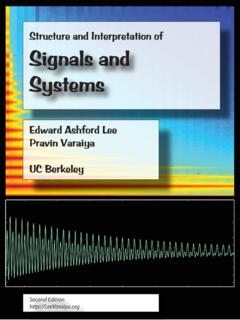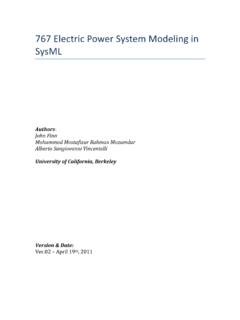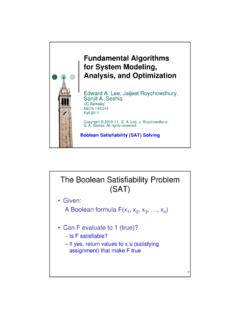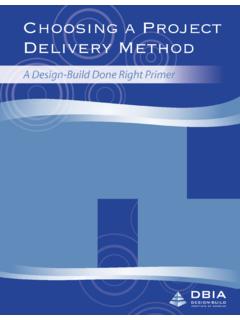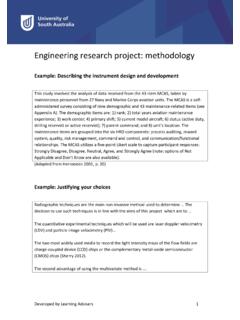Transcription of Sampling and Reconstruction - Ptolemy Project
1 Chapter 11 Sampling and ReconstructionDigital hardware, including computers, take actions in discrete steps. So they can deal with discrete-time signals, but they cannot directly handle the continuous-time signals that are prevalent in thephysical world. This chapter is about the interface between these two worlds, one continuous, theother discrete. A discrete-time signal is constructed bysamplinga continuous-time signal, and acontinuous-time signal isreconstructedbyinterpolatinga discrete-time SamplingA sampler for complex-valued signals is a systemSamplerT:[Reals Complex] [Integers Complex],( )whereTis thesampling interval(it has units of seconds/sample).
2 The system is depicted Thesampling frequencyorsample rateisfs=1/T, in units of samples/second (orsometimes, Hertz), or s=2 /T, in units radians/second. Ify=SamplerT(x)thenyis defined by n Integers,y(n) =x(nT).( ) Sampling a sinusoidLetx:Reals Realsbe the sinusoidal signal t Reals,x(t) =cos(2 f t),( )y: Integers Complexx: Reals ComplexSamplerTFigure 11. Sampling AND RECONSTRUCTIONB asics: UnitsRecall that frequency can be given with any of various units. The units of thefin ( ) and ( ) are Hertz, or cycles/second. In ( ), it is sensible to givethe frequency as =2 f, which has units of radians/second.
3 The constant2 hasunits of radians/cycle, so the units work out. Moreover, the time argumentthasunits of seconds, so the argument to the cosine function,2 f t, has units of radians,as the discrete time case ( ), it is sensible to give the frequency as2 f T, whichhas units of radians/sample. The Sampling intervalThas units of seconds/sample,so again the units work out. Moreover, the integernhas units of samples, so againthe argument to the cosine function,2 f nT, has units of radians, as general, when discussing continuous-time signals and their sampled discrete-time signals, it is important to be careful and consistent in the units used, or con-siderable confusion can result.
4 Many texts talk aboutnormalized frequencywhendiscussing discrete-time signals, by which they simply mean frequency in units ofradians/sample. This isnormalizedin the sense that it does not depend on thesampling the frequency of the sinewave in Hertz. Lety=SamplerT(x). Then n Integers,y(n) =cos(2 f nT).( )Although this looks similar to the continuous-time sinusoid, there is a fundamental difference. Be-cause the indexnis discrete, it turns out that the frequencyfis indistinguishable from frequencyf+fswhen looking at the discrete-time signal. This phenomenon is AliasingConsider another sinusoidal signalugiven by t Reals,u(t) =cos(2 (f+N fs)t),whereNis some integer andfs=1/T.
5 IfN6=0, then this signal is clearly different fromxin ( ).Letw=SamplerT(u).Then for alln Integers,w(n) =cos(2 (f+N fs)nT) =cos(2 f nT+2 Nn) =cos(2 f nT) =y(n),becauseNnis an integer. Thus, even thoughu6=x,SamplerT(u) =SamplerT(x). Thus, after beingsampled, the signalsxanduare indistinguishable. This phenomenon is calledaliasing, presumablybecause it implies that any discrete-time sinusoidal signal has many continuous-time identities (its identity is presumably its frequency). SAMPLING375 Example :A typical sample rate for voice signals isfs=8000samples/second,so the Sampling interval isT= A continuous-time sinusoid withfrequency 440 Hz, when sampled at this rate, is indistinguishable from a continuous-time sinusoid with frequency 8,440 Hz, when sampled at this same :Compact discs are created by Sampling audio signals atfs=44,100Hz, so the Sampling interval is aboutT= sec/sample.
6 A continuous-time si-nusoid with frequency 440 Hz, when sampled at this rate, is indistinguishable from acontinuous-time sinusoid with frequency 44,540 Hz, when sampled at this same frequency domain analysis of the previous chapters relied heavily on complex exponentialsignals. Recall that a cosine can be given as a sum of two complex exponentials, using Euler srelation,cos(2 f t) = (ei2 f t+e i2 f t).One of the complex exponentials is at frequencyf, an the other is at frequency f. Complexexponential exhibit the same aliasing behavior that we have illustrated for :Reals Complexbe t Reals,x(t) =ei2 f twherefis the frequency in Hertz.
7 Lety=SamplerT(x). Then for allninIntegers,y(n) =ei2 f nTConsider another complex exponential signalu,u(t) =ei2 (f+N fs)twhereNis some integer. Letw=SamplerT(u).Then for alln Integers,w(n) =ei2 (f+N fs)nT=ei2 f nTei2 N fsnT=ei2 f nT=y(n),becauseei2 N fsnT=1. Thus, as with sinusoids, when we sample a complex exponential signal withfrequencyfat sample ratefs, it is indistinguishable from one at frequencyf+fs(orf+N fsforany integerN).There is considerably more to this story. Mathematically, aliasing relates to the periodicity of thefrequency domain representation (the DTFT) of a discrete-time signal. We will also see that the ef-fects of aliasing on real-valued signals (like the cosine, but unlike the complex exponential) dependstrongly on the conjugate symmetry of the DTFT as 11.
8 Sampling AND RECONSTRUCTION8 kHz8 kHzContinuous-timesignal4 kHz4 kHzFrequency of the continuous-time sinusoidPerceivedpitchfrequencysweepFigu re :As the frequency of a continuous signal increases beyond theNyquist frequency, the perceived pitch starts to Perceived pitch experimentConsider the following a discrete-time audio signal with an 8,000 sam-ples/second sample rate according to the formula ( ). Let the frequencyfbegin at 0 Hz andsweep upwards through 4 kHz to (at least) 8 kHz. Use the audio output of a computer to listen tothe resulting sound. The result is illustrated in As the frequency of the continuous-timesinusoid rises, so does the perceived pitch, until the frequency reaches 4 kHz.
9 At that point, theperceived pitch begins to fall rather than rise, even as the frequency of the continuous-time sinusoidcontinues to rise. It will fall until the frequency reaches 8 kHz, at which point no sound is heard atall (the perceived pitch is 0 Hz). Then the perceived pitch begins to rise the perceived pitch rises from 0 after the frequencyfrises above 8000 Hz is not surprising. Wehave already determined that in a discrete-time signal, a frequency offis indistinguishable from afrequencyf+8000, assuming the sample rate is 8,000 samples/second. But why does the perceivedpitch drop whenfrises above 4 kHz?
10 The frequency 4 kHz,fs/2, is called theNyquist frequency, after Harry Nyquist, an engineer atBell Labs who, in the 1920s and 1930s, laid much of the groundwork for digital transmission ofinformation. The Nyquist frequency turns out to be a key threshold in the relationship betweendiscrete-time and continuous-time signals, more important even than the Sampling frequency. In-tuitively, this is because if we sample a sinusoid with a frequency below the Nyquist frequency(below half the Sampling frequency), then we take at least two samples per cycle of the sinusoid. Itshould be intuitively appealing that taking at least two samples per cycle of a sinusoid has some key1 This experiment can be performed at eal/eecs20/week13 Similar exper-iments are carried out in 10 3 1 (seconds)Figure :A sinusoid at kHz and samples taken at 8 The two sample minimum allows the samples to capture the oscillatory nature of thesinusoid.
